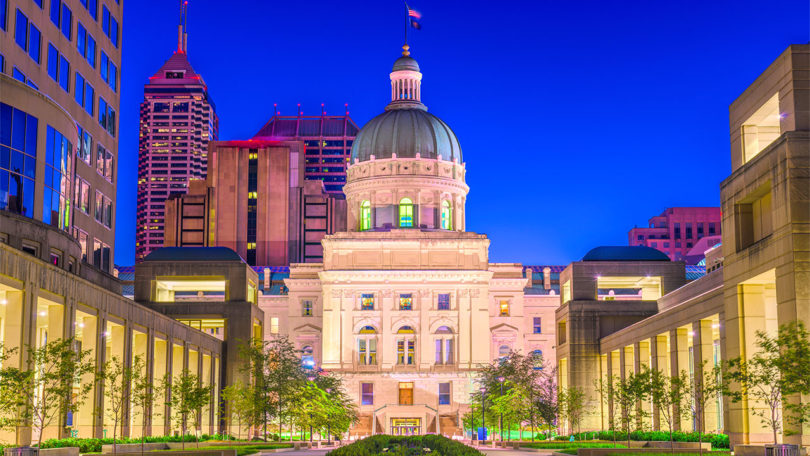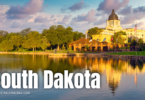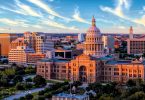Indianapolis is the capital of the state of Indiana. It is the most populous city in that state and is also the county seat of Marion County. It has a combined population with Marion County of about 872,680. In the United States, Indianapolis is the 17th most populous city, and the Indianapolis metropolitan area is the 34th most populous in the nation. The city is also the 16th largest city by land area in the country.
There have been Native American people inhabiting the area that is now Indianapolis since at least 2000 B.C. The Delaware tribe gave up their tribal lands in Indianapolis to the United States in 1818 in the Treaty of St. Mary’s. Indianapolis was officially founded as a planned city in 1821 and was intended from the beginning to be the capital of the new state’s government. The platting of the city was done by Alexander Ralston and Elias Pym Fordham using a one-mile square grid beside the White River.
When the National and Michigan roads were completed, and the railroad arrived in Indianapolis, the city became a popular hub for manufacturing and transportation. In fact, two of the nicknames of the city have to do with its old-time ties to transportation — these nicknames are “Crossroads of America” and “Railroad City.”
The local government is a city-county consolidation called Unigov, and is operated by a city-county council of twenty-five elected members and led by a mayor. Indianapolis itself is a modern-day hub for a variety of industries, such as finance, insurance, manufacturing, wholesale trade, government, education, health care, and services for professionals and businesses. There is also a strong niche market in the city for auto racing and amateur sports. There are three Fortune 500 companies located in the city, and the city has hosted a variety of international multi-sports events like the 1987 Pan-American Games and the 2001 World Police and Fire Games. It is best known for being the host of the largest single-day sporting event in the world, the Indianapolis 500.
Indianapolis is the location of the Indiana Pacers (part of the NBA), and the Indianapolis Colts (of the NFL). It is also the home of some important and well-known educational institutions, such as the University of Indianapolis, Marian University, Butler University, and Indiana University — Purdie University Indianapolis. In addition, there are several important cultural assets in the city, including the largest children’s museum in the world, one of the largest privately funded zoos in the nation, a number of historic buildings and sites, and an impressive collection of public art. Indianapolis is the home of the largest collection of monuments that are dedicated to veterans and war casualties in the country outside of Washington, D.C.
When Indiana gained statehood in 1816, the US Congress donated four different sections of federal land in the state to provide for a state capital. After the Delaware tribe gave up their lands in Indiana two years after it gained statehood (and agreed to move out of the area entirely by 1821), the land, called the New Purchase, included the area that would become Indianapolis.
There were plentiful federal lands available for purchase in Indiana, so this attracted many new settlers there. Most of them were from the eastern United States, and many were descendants of the original English settlers, as well as descendants of early settlers from France, Ireland, Germany, Scandinavia, and other parts of northern Europe. Most of the first settlers were Protestant, though a majority of the first German and Irish settlers in Indiana were Catholic. There were very few African-Americans there until after 1840.
The first European settlers to settle in Indianapolis were of the McCormick and Pogue families. The McCormick family is considered by most historians to be the first family to settle the city; a smaller contingent of historians believe it was the Pogue family. Whoever came first, the other family came shortly thereafter, around 1819, and settled in log cabins near a creek that later became known as Pogue’s Run, and also near the White River.
Indianapolis became the state capital in 1821 when Marion county was established. There was a combined town and county government until 1832 when Indianapolis was incorporated as a town. In 1847, Indianapolis was big enough that it was incorporated as a city. Samuel Henderson was the first mayor of the city and led a seven-member city council. The original charter of the city continued to be revised and updated as the city grew and times changed and became more modern. A U.S. district court was set up at Indianapolis in 1825.
The National Road was established as going through the city in 1827, and it was the first large, federally funded highway in the United States. The next big development in the town was a small section of the Indiana Central Canal, which opened in 1839, but it was not a success. The railroad came to Indianapolis in 1847 with the arrival of the Jeffersonville, Madison, and Indianapolis Railroad.
Other railroads followed it, and contributed significantly to the growth and thriving of the city. When Indianapolis Union Station opened in Indianapolis in 1853, it was the first railroad station of its kind in the world. All of these things brought more people and recognition to Indianapolis and made it one of the first truly modern cities in the United States. Indianapolis was soon a truly important U.S. city.
The city mostly allied with the Union during the Civil War. The city was a major point for the rallying of Union troops. After the war, the second industrial revolution took the city by storm, with factories of all kinds opening within its borders. Because of this, Indianapolis enacted some of the country’s earliest labor protection laws, which included the innovative mandate of a minimum wage, as well as regular working times, and improved working conditions.
Indianapolis is truly a modern city and has been almost from the beginning. It is on the cutting edge of new things. This makes it a valuable addition to the country.





